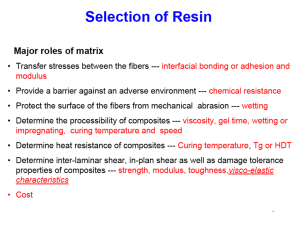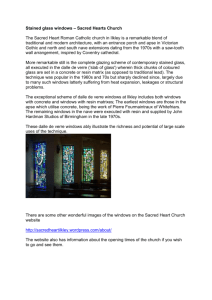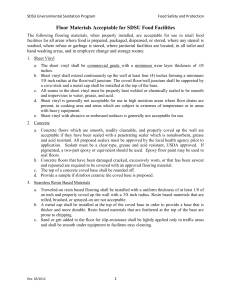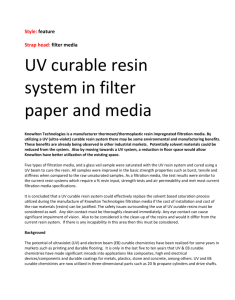- Mexichem
advertisement
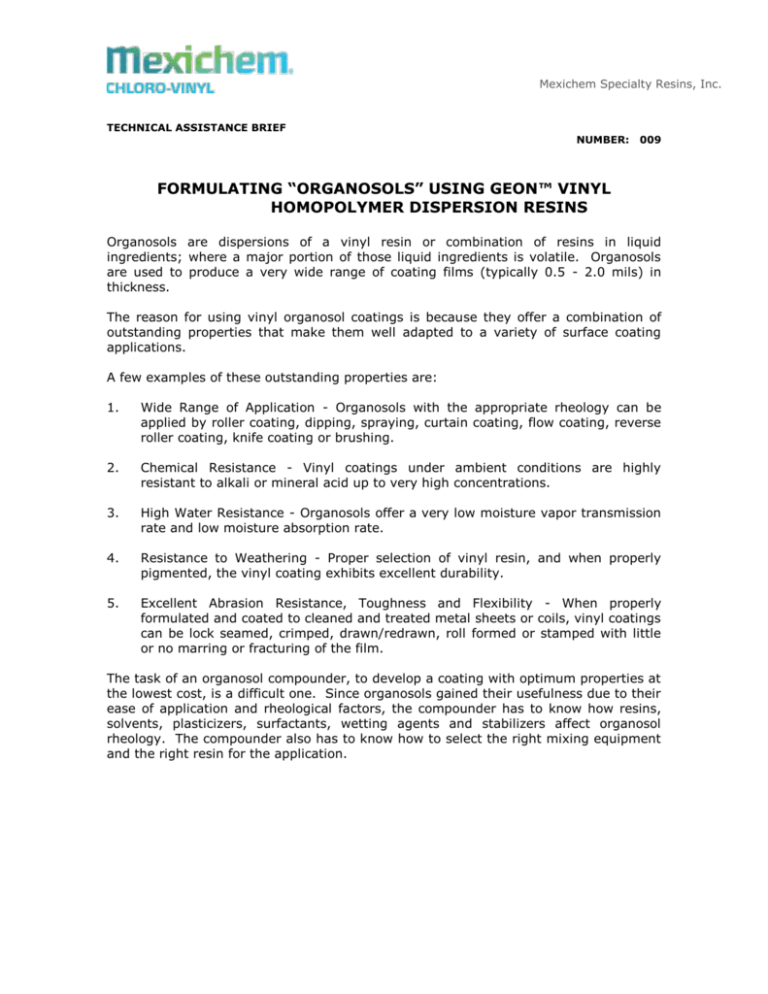
Mexichem Specialty Resins, Inc. TECHNICAL ASSISTANCE BRIEF NUMBER: 009 FORMULATING “ORGANOSOLS” USING GEON™ VINYL HOMOPOLYMER DISPERSION RESINS Organosols are dispersions of a vinyl resin or combination of resins in liquid ingredients; where a major portion of those liquid ingredients is volatile. Organosols are used to produce a very wide range of coating films (typically 0.5 - 2.0 mils) in thickness. The reason for using vinyl organosol coatings is because they offer a combination of outstanding properties that make them well adapted to a variety of surface coating applications. A few examples of these outstanding properties are: 1. Wide Range of Application - Organosols with the appropriate rheology can be applied by roller coating, dipping, spraying, curtain coating, flow coating, reverse roller coating, knife coating or brushing. 2. Chemical Resistance - Vinyl coatings under ambient conditions are highly resistant to alkali or mineral acid up to very high concentrations. 3. High Water Resistance - Organosols offer a very low moisture vapor transmission rate and low moisture absorption rate. 4. Resistance to Weathering - Proper selection of vinyl resin, and when properly pigmented, the vinyl coating exhibits excellent durability. 5. Excellent Abrasion Resistance, Toughness and Flexibility - When properly formulated and coated to cleaned and treated metal sheets or coils, vinyl coatings can be lock seamed, crimped, drawn/redrawn, roll formed or stamped with little or no marring or fracturing of the film. The task of an organosol compounder, to develop a coating with optimum properties at the lowest cost, is a difficult one. Since organosols gained their usefulness due to their ease of application and rheological factors, the compounder has to know how resins, solvents, plasticizers, surfactants, wetting agents and stabilizers affect organosol rheology. The compounder also has to know how to select the right mixing equipment and the right resin for the application. Mexichem Specialty Resins, Inc. RESIN SELECTION Mexichem Specialty Resins, Inc. produces six homopolymer vinyl dispersion resins: Geon™ 171, Geon™ 174, Geon™ 178, Geon™ 170-L100UF, Geon™ 170-L120UF and Geon™ 170-L140UF, which are designed specifically for high performance coatings. Each offers low and stable viscosity, excellent stain resistance, low odor and taste, and ease of mixing. With proper selection of the solvent system and plasticizer type, Geon™ Vinyl resins will easily disperse and deagglomerate to obtain a fine grind with a conventional high speed dissolver, roller mill, pebble mill or sand mill. These resins also have FDA acceptability in various areas. For detailed resin properties, refer to specific Product Data Sheets and/or the Dispersion Resin Selection Guide. PLASTICIZER SELECTION The function of the plasticizer is to impart impact resistance, improve low temperature flexibility of fused films and to provide thermal and light stability. Plasticizers are also polar compounds that form strong attachments to the resin particles and aid in the wetting and dispersion of these particles. The addition of plasticizer in the coating formulation will help to minimize the solvent retention in the film. Monomeric plasticizers are most commonly used; however, polymeric plasticizers afford low extractability and less migration. Certain plasticizers, such as citrates, epoxies and phthalates are used because they are approved for special FDA applications. Proportions of 10 to 50 parts of plasticizer per hundred parts of resin are typically used. Typical plasticizers such as phthalates, citrates, phosphates, epoxies, polymerics and azelates have very good compatibility with Geon™ Vinyl resins. SOLVENT SELECTION The solvents are added, along with plasticizer, to impart fluidity, solvation and dispersion of the vinyl resins. It should be done without over-solvating and flocculating of the resin particles. Solvents used in organosol applications can be categorized into two types; dispersants and diluents. Dispersants are polar liquids that form strong attachments to the resin particles and aid in wetting and dispersing these particles. Their ability to function as dispersants and their solvating power are related. Ketones possess high solvating power for vinyl resin, and yield low viscosity solutions with higher solid content, without gelling. Weaker solvents, such as esters and ether glycols, in conjunction with ketones, provide greater formulating latitude and a more even balance of properties. Diluents modify evaporation rates, lower solution viscosities and increase stability. Typical diluents are aromatic hydrocarbons such as toluene, xylene, Aromatic 100 and 150. Aliphatic hydrocarbons, such as mineral spirits and VM&P Naptha are also used, but at lower concentrations than aromatic diluents. Table 1 lists the typical dispersants and diluents used in vinyl organosols. For more exhaustive solvent properties for vinyl resin, see References 1 to 5. Attachment I gives a quick review on formulating organosols. Mexichem Specialty Resins, Inc. MIXING ORGANOSOLS For the preparation of organosols, high speed dispersers or sand mills are recommended over low intensity or slow speed mixers. Resin should be added slowly to the plasticizer / solvent / diluent blend, in order to prevent lumping. In some cases, part of the liquid blend is held back, and when all resin particles are dispersed, the held back liquid portion is added while vigorously agitating the slurry. References 6 and 7 provide more details on mixing equipment. Refer to Attachment II for tips on mixing organosols. All precautions for the safe handling of organic solvents and diluents should be followed. Work and storage areas should be ventilated. Equipment should be grounded to prevent the buildup of static electricity. Consult solvent manufacturers for safe handling procedures and health effects of all solvents and diluents. REFERENCES 1. “Solvents for Vinyl Resins”, Shell Chemical Company, Industrial Chemicals Division. IC-627R 2. “Solvent Properties Chart”, Shell Chemical Company, Industrial Chemicals Division. SC-4887 3. “Glycol Esters”, Shell Chemical Company, Industrial Chemicals Division. SC:24-82 4. “Shell Alcohols”, Shell Chemical Company, Industrial Chemicals Division. SC:24-84 5. “Shell Ketone Solvents”, Shell Chemical Company, Industrial Chemicals Division. SC:53-84 6. A. Sarvetnick, “Plastisols and Organosols”, New York, Van Nostand Rheinhold Company. 1972 Edition; Chapter 8, pages 125 to 142 7. Roesler & Hyman Metz, “Mixing & Compounding Equipment”, Chapter 20 Encyclopedia of PVC, Volume 2, 1977 Edition, Marcel Decker, Inc. 8. Plastisol Processing Guide, The Geon Company, Booklet “G-74”. 9. Organosol Formulations for Stir-In-Dispersion-Type PVC Resins, A. C. Werner, Modern Plastics, July 1959 Mexichem Specialty Resins, Inc. TABLE 1 TYPICAL SOLVENTS FOR ORGANOSOLS DISPERSANTS STRONGER WEAKER MIBK DIBK MEK METHYL ISOAMYL KEYTONE ISOPHORONE CYCLONEXANONE UCAR™ METHYL CELLOSOLVE UCAR™ CARBITOL SOLVENT UCAR™ CELLOSOLVE SOLVENT UCAR™ BUTYL CELLOSOLVE UCAR™ CELLOSOLVE ACETATE METHYL AMYL ACETATE DIACETONE ALCOHOL 2 ETHYL HEXYL ALCOHOL DILUENTS (POOR OR NON-SOLVENTS) AROMATIC XYLENE AROMATIC 100 AROMATIC 150 TOLUENE ALIPHATIC VARSOL NO. 2 SHELL SOL 140 VM&P NAPTHA MINERAL SPIRITS Mexichem Specialty Resins, Inc. ATTACHMENT I TIPS ON FORMULATING ORGANOSOLS (GENERAL NOTES) A typical organosol may contain 100 parts of vinyl resin, up to 100 parts of plasticizer, up to 100 parts of pigments and a combination of active solvents (dispersants) and diluents. Heat stabilizers are used to minimize the degradation of vinyl during processing. In a pigmented formulation, a sufficient quantity of pigment will help to screen out UV radiation. In a clear application, up to 2 parts of a commercial UV absorber will minimize UV degradation. Consult suppliers of stabilizers for specific recommendations. The viscosity of PVC organosols is influenced by resin type, concentration, plasticizer level, ratio of active solvent to diluent, and organosol temperature. Plasticizers and active solvents are both dispersants and help to wet the resin particles and disperse agglomerates. Diluents reduce viscosity and keep the resin from swelling. The balance point is the ratio of dispersant and diluent that gives minimum viscosity. The balance point changes with resin particle size distribution, residual surfactant, and molecular weight. If the dispersant evaporates faster than the diluent, the PVC film may crack, this is also referred to as mud-cracking. To prevent mud-cracking and promote film integrity, use a diluent, which is a blend of aromatics and aliphatics. The use of more active dispersants or a PVC copolymer resin will also enhance film integrity. The use of silicas, Barium Sulfate, clays, talcs and carbonates will help reduce cost, control gloss, and provide higher coating weight. ATTACHMENT II TIPS ON MIXING ORGANOSOLS High speed dispersers or sand mills are preferred over the use of pebble mills or roller mills. Low intensity mixers are not as efficient as high-shear mixers. In a pigmented formulation, two dispersion steps are involved: dispersing vinyl resin and dispersing pigments. Add the plasticizer, active solvent and diluent to the kettle. Under agitation, add the resin slowly to prevent lumping. If lumping still occurs, hold back part of the active solvent. When all the resin is thoroughly wetted, agitate vigorously and add the remaining portion of the active solvent. At this point, add predispersed pigments and other formulation ingredients. Make sure the organosol temperature is controlled below 90F. At higher temperatures, dispersion resin will oversolvate and high viscosity will result. If possible, the PVC resin should be exposed to only the plasticizer during the initial mixing step. However, since this is not practical in most cases, the ultimate goal should be to minimize the Mexichem Specialty Resins, Inc. exposure of the PVC resin to the active solvent during the initial mixing. Initial exposure of the PVC resin to the active solvent will result in the formation of hard particles, which will absorb minimum amounts of the other raw materials, including stabilizers and pigments. PVC resin must not be allowed to build-up on mixing vessel surfaces. The sloughing off of this material from mixing vessel surfaces will result in large agglomerates in the organosol. Undesirable foreign particles or undispersed ingredients can be removed by the use of filters. Using the appropriate Geon™ dispersion resin, Hegman grinds of 4-6+ could be achieved by using a high intensity mixer. This organosol can be further ground by passing it through a vertical or horizontal sand mill. With the use of a sand mill, a Hegman grind of 7+ can be achieved. © Mexichem Specialty Resins, Inc. 2013 The information contained herein is believed to be reliable, but no representations, guarantees or warranties of any kind are made as to its accuracy, suitability for particular applications or the results to be obtained therefrom. The information is based on laboratory work with small-scale equipment and does not necessarily indicate end product performance. Because of the variations in methods, conditions and equipment used commercially in processing these materials, no warranties or guarantees are made as to the suitability of the products for the application disclosed. Full-scale testing and end product performance are the responsibility of the user. Mexichem Specialty Resins, Inc. shall not be liable for and the customer assumes all risk and liability of any use or handling of any material beyond Mexichem Specialty Resins, Inc.’s direct control. The SELLER MAKES NO WARRANTIES, EXPRESS OR IMPLIED, INCLUDING, BUT NOT LIMITED TO, THE IMPLIED WARRANTIES OF MERCHANTABILITY AND FITNESS FOR A PARTICULAR PURPOSE. Nothing contained herein is to be considered as permission, recommendation, nor as an inducement to practice any patented invention without permission of the patent owner. TAB-009 Mexichem Specialty Resins, Inc. JUL 2013
